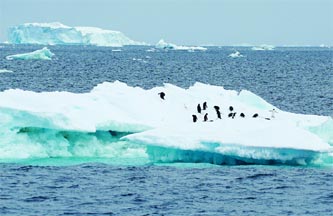
Antarctica’s ‘landfast’ ice, the stationary sea ice forming around and remaining attached to the coastline or among grounded icebergs, is likely to reduce by the end of this century, in its season length, thickness and extent, according to a new review. A critical breeding habitat for emperor penguins and essential for their survival, landfast ice provides a key substrate for early-season primary production fuelling coastal marine food cycles.
Along with documenting a recent dramatic crash in its extent, the first-ever broad review of Antarctic landfast ice highlighted its far-reaching importance in the Earth system and identified priorities for future research, scientists involved in the review said.
“Landfast ice needs to be distinguished from other types of sea ice for the different roles it plays in the global climate system,” said Alex Fraser, an Australian Antarctic Program Partnership scientist who co-led the team of 23 international authors. He along with the other co-lead Pat Wongpan have published their review in the journal Reviews of Geophysics. “Our comprehensive review synthesises the current state of knowledge of Antarctic landfast ice, from its physical and mechanical properties through to its major roles in key glaciological, oceanographic, atmospheric, biogeochemical and biological processes,” said Fraser. However, because landfast ice is not currently represented in global climate models, projections were highly uncertain, they said.
The review noted that the “incorporation of prognostic fast ice into regional and circum-Antarctic coupled sea ice-ocean models is a high priority.”
“The formation of Antarctic fast ice results from complicated interactions between sea ice, ocean, atmosphere, coastal configuration, bathymetry and grounded icebergs (of which no large-scale dataset currently exists), and its accurate model representation is perhaps a more challenging problem than its Arctic counterpart,” the authors wrote.
The researchers said that their analysis demonstrated the speed with which landfast ice can respond to environmental change. “From satellite records, we created a new yearly time-series of landfast ice from 2000-2022 which shows that the annual minimum circum-Antarctic fast-ice extent reached a dramatic record low in March 2022,” said Fraser.
Landfast ice extent dropped to just 1,23,200 sqkm (square kilometres) in March 2022 (its normal March range is between 1,68,600 and 2,95,200 sqkm). “Regions where landfast ice was lost previously had fast-ice cover in early-mid March every year from 2000 to 2021,” he said. Source: PTI





Be the first to comment